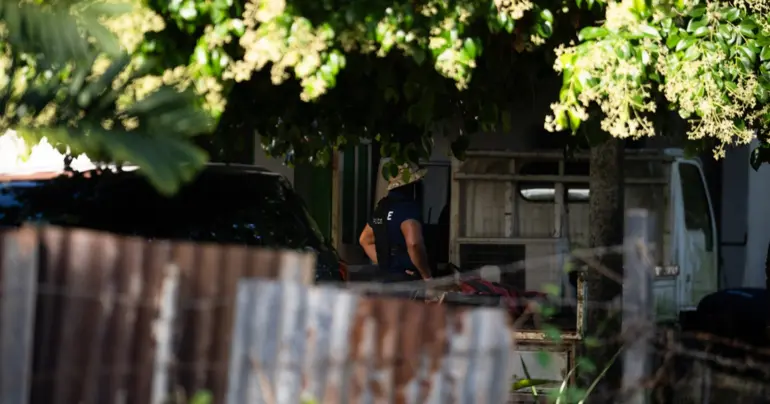Stop order on banana exports remain
 By Sapeer Mayron
•
18 August 2019, 8:00PM
By Sapeer Mayron
•
18 August 2019, 8:00PM
The Chief Executive Officer of the Ministry of Agriculture and Fisheries (M.A.F.), Tilafono David Hunter, has confirmed the Ministry is not ready to lift the stop order on banana exports.
Speaking to the Samoa Observer, he said Samoa’s banana industry is still not ready to meet New Zealand’s tough biosecurity regulations.
For now, Tilafono said banana farmers should leave the “headache” of exporting to Ah Liki’s Tanumapua Farm which has been successfully following national guidelines on preparing and exporting bananas.
He said the Ministry is continuing to hold training sessions for farmers on the guidelines and is working closely with the Banana Growers Association, meeting as recently as last Thursday evening:
“We hope that eventually the association members' contribution to the export market will kick in again,” he said.
And, as long as they follow the guidelines, they will eventually be ready to join Ah Liki in maximising the large Kiwi market, said Tilafono.
Crops Division Assistant C.E.O., Moafanua Tolo Iosefa, said banana growers are getting regular support from his Ministry on sanitation and pest control issues, including a heavily-subsidised spraying against diseases like black leaf streak and banana bunchy top virus.
But he does not want them to rely on the Ministry forever, he said, just until they are “fully established.”
Future training will only be for farmers who are aspiring exporters and willing to do the work, he added, saying the Association executive will be helping the ministry choose those farmers.
“It is not good to push people who neglect their farm,” Moafanua said.
“Only those people who are willing to continue with their banana farms will do training.”
Preparations for export are not wasted effort, Tilafono said. Banana quality is improving and farmers are making good money locally, especially over the Pacific Games, he said.
In January and February, the Ah Liki Farm and other members of the Banana Growers' Association exported seven tonnes of banana per month to New Zealand from the Ah Liki packing house in Tanumapua.
But in March some banana farmers in the association filled the container from the Government packhouse, and it was rejected by New Zealand, prompting the M.A.F. Minister Lopao’o Natanielu Mua to halt all exports, with the exception of the Ah Liki farm.
Crops Division Assistant C.E.O, Moafanua Tolo Iosefa, said the Ministry shares the responsibility for that shipment being rejected.
“We are there to assist in terms of looking at the quality of the export and one thing I know for sure that we missed in the last container, is that we failed to monitor the timing of the harvest for export,” he said.
“We believed they could do it themselves but we found out later they did not follow guidelines.”
The March export failure was a good learning experience for the farmers and Ministry, Tilafono said.
“We all take full responsibility of it,” he said.
“It’s not a good thing, but then on the bright side it was not wasted effort, they still had markets to sell in.”
Ah Liki farm manager Leota Laumata Peleta said the biosecurity requirements are especially tough, and that it can be expensive for small holder farmers to afford the infrastructure to meet them.
Even hiring enough workers to maintain a plantation at export standard can be a barrier, he said: “We have ten workers responsible for the entire bananas, I don’t think the other small holders can do that.”
And bananas need to be carefully and diligently marked when they begin fruiting to monitor their maturity. Bananas should be exported at 11 or 12 weeks old, in order to reach New Zealand after the five-day trip as 13 week old bunches.
But if they are not marked clearly bananas can go out late and, as they ripen inside the container, they release acetylene and ripen the entire container’s load along with them.
“Samoan farmers are very experienced with basing harvesting decisions on visual observations,” Tilafono said.
“But it may be off by a week of the actual week of harvesting because you have to take into account the time it takes to pack it, container it and the time it takes the container to reach its final destination.”
He said it may be another year or two before smallholder farmers are practised enough in the banana growing and exporting guidelines so that the export pathway can be used again.
Leota said the Tanumapua farm gates remain open to anyone who needs help.
“The whole idea is to revive the banana industry. So we support the smallholders,” he said, adding farmers can bring their bunches to export with Ah Liki if they have carefully followed the guidelines.
And though the Ah Liki farm is still allowed to export to New Zealand, Leota said they have opted not to resume exports yet, and are focusing on the lucrative local market.
Leota said there is high demand for ripe banana in Samoa and the taro market is weakening.
Their resources have also been depleted, after strong winds felled 30 per cent of the banana trees in July.
But there is still plenty to meet that local demand, he said, as the farm produces seven to eight tonnes of ripe banana, and three to four tonnes of green banana per week.
Leota said he hopes to return to exporting a container a month in November or December, depending on the weather and the farms expanding plantation’s success.
Meanwhile, New Zealand is trying its hand at its own commercial banana industry. In 2018, the Ministry of Business, Innovation and Employment (M.B.I.E) awarded a NZ$93,445 grant to Tai Pukenga and AgResearch to develop a plantation in Gisborne.
The project is beginning by growing tissue culture at Massey University in Palmerston North before they are planted in Gisborne where the temperature has proved promising.
Tai Pukenga’s project manager, Trevor Mills, said Gisborne has seen “quite a change” in the climate for several years.
“Most of our rainfall comes from the north-east, off the Pacific Ocean, which has come from the Pacific Islands," Mr Mills said.
“We have had situations in the middle of winter here in the last couple of seasons, with temperatures at two am of 16 degrees Celsius."
Tags
 By Sapeer Mayron
•
18 August 2019, 8:00PM
By Sapeer Mayron
•
18 August 2019, 8:00PM











